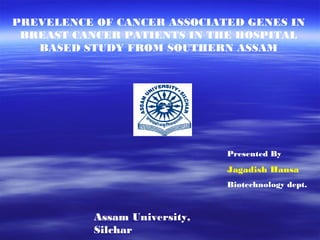
Breast cancer research
- 1. PREVELENCE OF CANCER ASSOCIATED GENES IN BREAST CANCER PATIENTS IN THE HOSPITAL BASED STUDY FROM SOUTHERN ASSAM Presented By Jagadish Hansa Biotechnology dept. Assam University, Silchar
- 2. What is breast cancer ?? Umberto Veronesi said if India does not put in place a vigorous mechanism for early detection and an awareness building exercise, then India will have more breast cancer patient as compare to other part of world in 2020. Types of undesired cell growth in breast:- Fibroadenoma Cyst Abscess Fibrocystic disease Tumor TUMOR
- 3. Symptoms of breast cancer Change in nipple Change in direction of nipple Eczematous changes of nipple Presence of a lump or thickening Persistent discomfort and pain Change in nipple discharge Change in appearance of moles
- 4. FACTORS EFFECTING BREAST Simply being a woman is the main risk factor for Developing breast cancer. Two types:- sporadic and hereditary breast cancer. Hereditary cancer is by BRCA1 and BRCA2 gene. Commonest cause of death for woman (35-55yr). Age Family History Genetic Factors Reproductive History Radiation Race Menstrual Treatment with History DES
- 5. BRCA1 - location Localized to the long arm of chromosome 17q21. Distributed over 100,000 base pairs of DNA. 24 exons (22 coding + 2 non-coding) which encode a protein that is 1,863 aa in length. BRCT (C-terminal of BRCA) domain – Consists of 2 conserved BRCT repeats~90-100 amino acids long. N-terminal – ring-finger domain where Bard1 protein bind.
- 6. BRCA2 Localized to chromosome 13q12-13. 27 encoding exons distributed over roughly 70 kb of genomic DNA. The exons encode a known sequence of 3418 aa length. Carriers also have increased risks of pancreatic, prostate, laryngeal, and ocular cancers.
- 7. Normal function!!! BRCA 1 and BRCA 2 – Known as breast and ovarian cancer susceptibility genes – Tumor suppressor genes regulate the cycle of cell division by keeping cells from growing and dividing too rapidly or in an uncontrolled way inhibit the growth of cells that line the milk ducts in the breast – Involved in many other functions including control of DNA replication and damage repair
- 8. Abnormal behaviour of BRCA genes BRCA-1 Germline mutations within BRCA1 predispose carriers (heterozyg- otes) to early onset breast and 80% risk of breast cancer. Over 100 different mutations are associated with the BRCA1. Three main anomalies account for approx. 19% of the mutations:- 1) 185delAG in codon 23, 2) 5382insC on codon 1756, 3) 4184del4 in codon 1355. Mutations found at the 5’ end increased risk of ovarian cancer. BRCA-2 BRCA2 mutations confer higher risk of male breast cancer. One mutation occur frequently: 6174delT Similar statistics for BRCA2 carriers, but later age of onset and lead to other tumors: gastric, colon, pancreatic, prostate, and melanoma
- 10. Thank you all for your kind attention
Hinweis der Redaktion
- Fibroadenomas are fibrous, benign (noncancerous) growths in breast tissue. These growths are solid, usually painless lumps that are not attached to any structures in the breast. A fibroadenoma is usually removed surgically, using a local anesthetic. A cyst is a fluid-filled sac. The cause of breast cysts is unknown. In the vast majority of cases, cysts are not harmful, although they may cause pain. Cysts disappear sometimes by themselves, or your doctor may draw out the fluid with a needle. A breast abscess is a collection of pus, resulting from an infection. Symptoms may include tenderness and inflammation. Antibiotics are prescribed to treat the infection, and your doctor may drain the pus. Fibrocystic breast disease is a common condition characterized by an increase in the fibrous and glandular tissues in the breasts, which results in small, nodular cysts, noncancerous lumpiness, and tenderness. Although called a "disease," this condition is not a disease. There is no specific treatment for fibrocystic disease. Treatment of the cysts may be all that is needed (see Cysts above). A tumor that is precancerous or cancerous usually shows up as a white area on a mammogram even before it can be felt. In cases where the tumor is cancerous, it may appear as a white area with radiating arms. A cancerous tumor may have no symptoms or may cause swelling, tenderness, discharge from the nipple or indentation of the nipple, or a dimpled appearance in the skin over the tumor (see inset). A breast biopsy is helpful in determining whether a mass is cancerous.
- Let’s talk about the most common risk factors that cannot be changed. Besides being a woman, you are at risk As you get older If you or close blood relatives have had or have this disease. A woman with breast cancer has 3 to 4 times a greater chance of developing a new cancer. Depending on your race: we talked before that white women are more frequently diagnosed with breast cancer than black women. But black women die more of this disease. Asian, Hispanic, and American Indian women are at lower risk. Treatment w/ DES (Diethylstilbestrol)- Between 1940 and 1960, some pregnant women were given DES to lower their chances of miscarriage. Recent studies show that these women have a 35% increased risk of getting breast cancer. Radiation: women who have had chest radiation treatment have a greater risk of breast cancer. Genetic factors: about 1 case of breast cancer in 10 is linked to changes/mutations in certain genes. Menstrual history: women having her menstrual periods before 12 years of age or who went through menopause after age 50 have a slightly higher risk. Reproductive history: women that have no children or who have their first child after 30 have a 40% higher risk.
